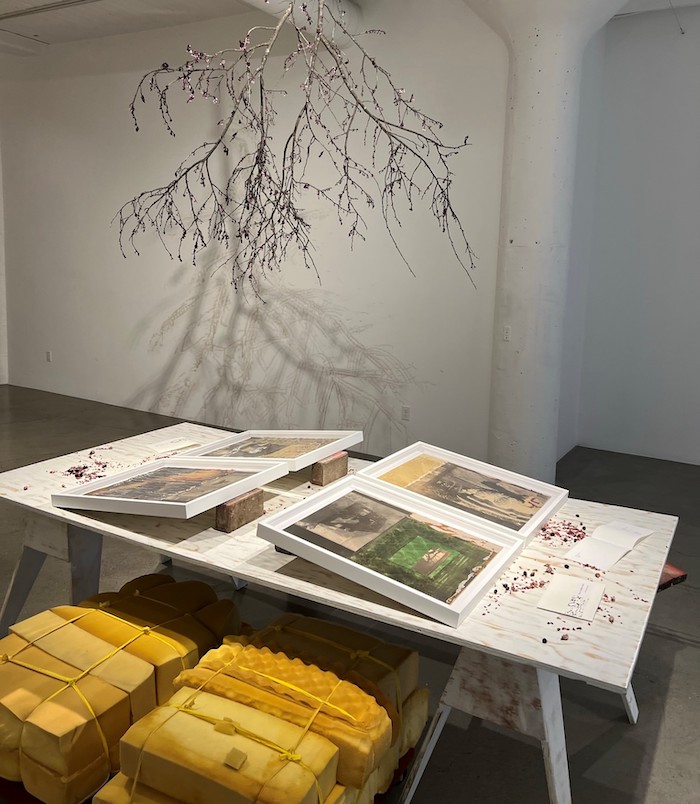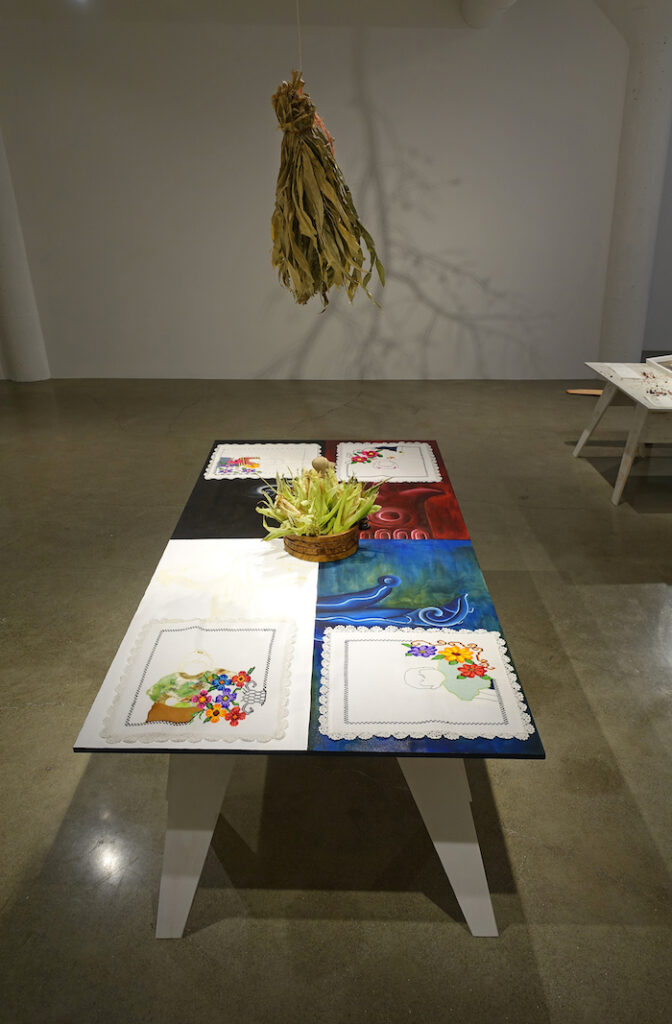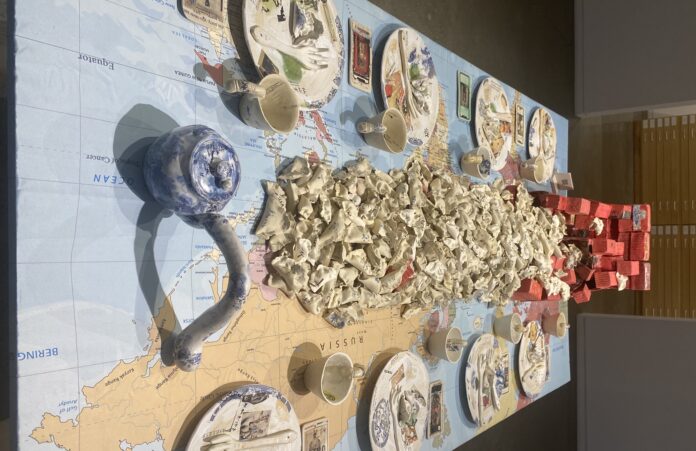The artists gave each other prompts: decoys, Pompeii, the number four, family, the destruction of nature. What they created? Ceramic dumplings, a long poem, collages of Italian posters, ducks made of dough, embroidered servilletas (tortilla-warming napkins), dinner plates about gay marriage.
In “Sobremesa” at Catharine Clark Gallery through March 18 (the last table will be unveiled March 9), six artists or artist teams created six tables, each responding to the one before. Since the gallery was undergoing construction due to an expansion, Clark, the gallery’s owner, decided to lean into the transition rather than hide it. She hit on the idea of a sheet of plywood on sawhorses, so they would be able to throw plastic on top to avoid dust and to move things around if they needed to. To further shake things up, instead of being on Saturdays as usual, openings for each table have been on Thursday evenings. The name sobremesa comes from the Spanish word meaning lingering at the table when the meal is over.
Anton Stuebner, the gallery’s director, curated the artists, starting with Deborah Oropallo (who has previously showed at the gallery) and Michael Goldin. Thinking about how drought and floods were affecting their farm in Novato where they make cheese, raise animals, and grow fruit, they created “FOWL WEATHER,” which features ducks baked out of bread (inspired by carbonized loaves found in an oven centuries after the volcanic eruption in Pompeii and shown in Last Supper in Pompeii: From the Table to the Grave at the Legion of Honor in 2021), pomegranates, and roots from trees from their farm, pulled up during storms.
Thus with the prompts of duck, Pompeii, and Italy, Amy Trachtenberg made four collages from posters she’d torn off walls in Italy (they include ones highlighting Franz Kafka and Marcel Proust) which were starting to peel off, for “I have two names and at least two languages—for dreaming.” Rather than responding to actual ducks, she considered the phrase, “sitting ducks,” which made her think of victims of war.
“I was reading a lot of work related to people in war zones and people fleeing, and thinking about unwilling people caught in various conflicts, and so that’s how I responded,” Trachtenberg said. “In my collages, I think they are dealing with different kinds of tyranny and anarchy, and also my own family’s personal history, being Central European Jews, and a whole generation just lost with no trace.”
That personal history includes her grandmother, who visited Trachtenberg when she lived in Paris.
“It was her first time going back to Europe after her forced emigration from Poland as a really young child, and she stayed with me in my squat and had all these memories, almost like recovered memories, of her life as a child: having an outhouse and what the streets were like, and the cobblestones,” Trachtenberg said. “It led me into writing, and then I felt like, ‘Well, I’ve got to make a book.’” Trachtenberg made a book of a long poem, Rose Madder Lake, named after a bright pigment. Rose was also Trachtenberg’s grandmother’s name.
Trachtenberg also cut off a branch from the plum tree she planted in front of her Bernal Heights home 35 years ago and suspended it above her table in response to the tree roots in FOWL WEATHER.

One of the prompts Trachtenberg gave Arleene Correa Valencia was the number four, and that was all Correa Valencia needed to create “Mesa: Nuestra Madre Tierra / Table: Our Mother Earth,” which has a basket of corn at the center of the table and four tortilla napkins embroidered with images of Correa Valencia and her three siblings.
“Connecting to the number four was really easy, because there’s four of us, me and my siblings. And there’s the relationship to our ancestral practices in the sense that we honor the four colors of corn and the four directions and the four elements and the four stages of life,” Correa Valencia said. “So, when Amy said ‘four,’ I was like, ‘I got it. I know what it is!’”
In the textile portraits, Correa Valencia and her siblings’ faces are blank. “My work in general deals with a lot of the visibility and invisibility of undocumented communities,” she said. “Specifically reflecting on my family and our history of being undocumented for the last 25 years.”
In sculptor Wanxin Zhang’s next table, “Excavated Dumpling Platters in 2203,” piles of ceramic dumplings spill out of a container ship, and there are eight place setting—doubling the four in Valencia’s. Then Sandow Birk and Elyse Pignolet’s table, “Marriage,” has six plates, each with a marriage that was forbidden at one time such as Isabella and Anthony, referencing the marriage of two enslaved Africans who arrived in Virginia in 1619 on the first slave ship.” The last table, Reniel Del Rosario and Johany Huinac De Leon’s, will be unveiled on March 9.
Correa Valencia says she was nervous to create something in such a short amount of time with artists she respects, but she loved being part of “Sobremesa.”
“This was such a breath of fresh air to say, ‘Well, we’re going to do this playful thing, and it might be great, or it might not be great.’ We’re just going to play in the studio, and we so often forget to play,” she said. “I was so amazed by the threads and the connections that were created between each individual and each table. It was more than I could ever ask for.”

Food that accompanied the opening of each table helped create that sense of community. No catering was arranged, but professional chefs and home cooks volunteered to make food and drinks based on the theme of the table. Loretta Keller, Gilliam Tyrnauer, and Orchid came up with menus like a buckwheat pastry with a farmer’s cheese and a rose petal cosmopolitan for Trachtenberg’s table, and deconstructed dumplings and a whiskey and tea drink for Zhang’s. For the unveiling of Correa Valencia’s table, her mother brought a nopales salad, with chips and her homemade salsa, along with margaritas.
And for Birk and Pignolet? Clark and Birk have spent their professional career together—about 30 years. The relationship between a gallery and an artist is like a marriage in some ways, Clark says, so she made a celebratory meal to honor that, with Italian wedding soup, Mexican wedding cookies, prosecco, and Jordan almonds. Who knows what will accompany Reniel Del Rosario and Johany Huinac De Leon’s table on March 9?
Both Correa Valencia and Trachtenberg call Clark brave for opening up her gallery to let artists create whatever they wanted in just a week, but she says it’s just part of her philosophy. “You need to trust the artist,” Clark said. “It comes from the standpoint of having that kind of faith in the artists’ ability to fill the assignment in a way that would be compelling.”
Trachtenberg, for one, is ready to do it all again.
“It’s fantastic,” she said. “I really hope they do such a show every year. I think it’s brought things out of our various ways of working, and the community built within gallery couldn’t happen otherwise. It’s been a lot of fun, and it’s lovely hearing people talk about what spurred them on and what their process was.”
SOBREMESA runs through March 18 at Catharine Clark Gallery, SF. The opening for the last table is Thu/9, 5:30pm to 7:30pm. More info here.






